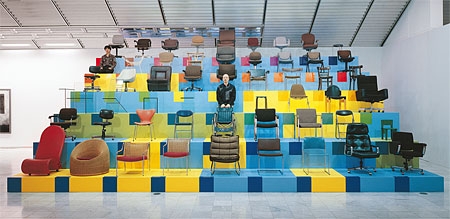Portrait of the Museum as a Chair
25 October – 11 December 2001
In: "Museum as Subjects," The National Museum of Art, Osaka, Japan
52 chairs, information sheets (Japanese / English), podium; total dimensions: 130 x 354 x 236 inches
In 2001, Hiroyuki Nakanishi, curator at the National Art Museum in Osaka, invited Christian Philipp Müller to develop a project for his exhibition, “The Museum as Subjects.“ Until 2004, the museum stood in the EXPO park (built in 1970) in Suita-City, a landscape of architectural remnants from the EXPO and the new Museum of Ethnology edifice, built according to the plans of Kisho Kurokawa. Kyoshi Kawasaki designed The National Art Museum in 1977 for the EXPO. After modifications, it was then opened as a permanent exhibition space. The museum’s first design exhibition, “Design and Art of Modern Chairs,” took place in 1978. The site of the museum and the odd distribution of various designer chairs throughout the exhibition apparatus inspired Müller to use the museum as the central theme of his project, based on its chairs. He made a portrait of the museum, in which he created a typology of the 54 kinds of chairs in the National Museum of Art. In the exhibition itself, Müller placed the different types of chairs, organized according to their year of purchase, on a podium-like construction. The surfaces where they were positioned were color coded to differentiate the various hierarchical and functional levels of the institution from one another. The year of purchase as well as the status of the chair within the workings of the museum could be construed from the positioning and color environment of the chairs. The groupings ranged from visitor chairs (blue), employee chairs (yellow), and the six chairs that belonged to the collection of the museum (green). Employees were given similar replacement chairs for the duration of the exhibition, since it was prohibited to sit on the exhibited chairs.
In 2006, Müller published a book in the “Bawag Foundation Edition: Portrait of the Museum as a Chair.” Not only does the book describe the past exhibition, but it also provides a complete catalogue of the chair types. With photographs in the style of modern design catalogues, the book reproduces the color patterning of the exhibition design, and provides a more precise classification in which the designer, model, and exact location of the chair within the museum are indicated. Through the catalogue of chair types and in the accompanying table, the hierarchies within the institution can be garnered from a selected piece of furniture. As in many of his previous works, in this case, not only did Müller rely on given material, but he extended his research within the museum’s holdings by comparing purchasing and holding lists. In correspondence with this accuracy, there are two empty pages that lack an image for the catalogued entry. One chair got lost in storage after it was purchased, and the museum café rented another during a popular exhibition of Egyptian antiquities, but when the exhibition closed, the chair was not purchased.



